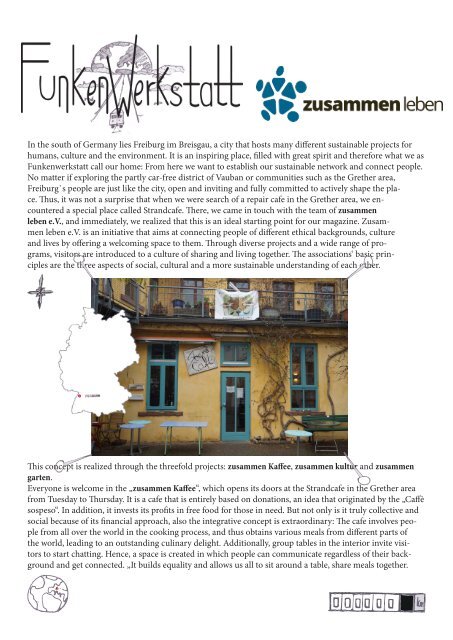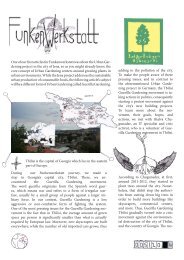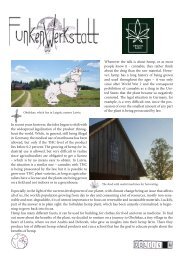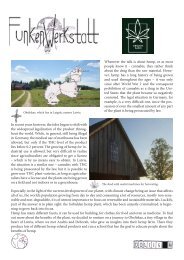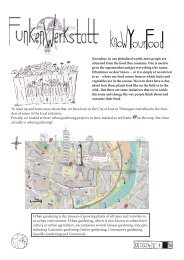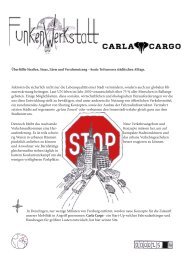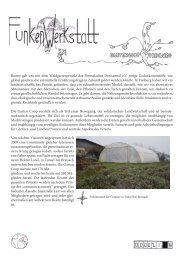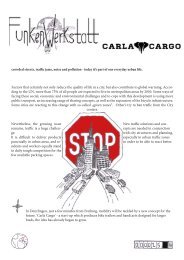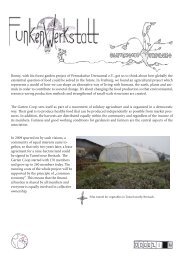zusammen leben e.V. english
Create successful ePaper yourself
Turn your PDF publications into a flip-book with our unique Google optimized e-Paper software.
In the south of Germany lies Freiburg im Breisgau, a city that hosts many different sustainable projects for<br />
humans, culture and the environment. It is an inspiring place, filled with great spirit and therefore what we as<br />
Funkenwerkstatt call our home: From here we want to establish our sustainable network and connect people.<br />
No matter if exploring the partly car-free district of Vauban or communities such as the Grether area,<br />
Freiburg`s people are just like the city, open and inviting and fully committed to actively shape the place.<br />
Thus, it was not a surprise that when we were search of a repair cafe in the Grether area, we encountered<br />
a special place called Strandcafe. There, we came in touch with the team of <strong>zusammen</strong><br />
<strong>leben</strong> e.V., and immediately, we realized that this is an ideal starting point for our magazine. Zusammen<br />
<strong>leben</strong> e.V. is an initiative that aims at connecting people of different ethical backgrounds, culture<br />
and lives by offering a welcoming space to them. Through diverse projects and a wide range of programs,<br />
visitors are introduced to a culture of sharing and living together. The associations‘ basic principles<br />
are the three aspects of social, cultural and a more sustainable understanding of each other.<br />
This concept is realized through the threefold projects: <strong>zusammen</strong> Kaffee, <strong>zusammen</strong> kultur and <strong>zusammen</strong><br />
garten.<br />
Everyone is welcome in the „<strong>zusammen</strong> Kaffee“, which opens its doors at the Strandcafe in the Grether area<br />
from Tuesday to Thursday. It is a cafe that is entirely based on donations, an idea that originated by the „Caffè<br />
sospeso“. In addition, it invests its profits in free food for those in need. But not only is it truly collective and<br />
social because of its financial approach, also the integrative concept is extraordinary: The cafe involves people<br />
from all over the world in the cooking process, and thus obtains various meals from different parts of<br />
the world, leading to an outstanding culinary delight. Additionally, group tables in the interior invite visitors<br />
to start chatting. Hence, a space is created in which people can communicate regardless of their background<br />
and get connected. „It builds equality and allows us all to sit around a table, share meals together.
It is an integrative approach that I find very beautiful. I am already excited whom I will get to know and talk<br />
to in the upcoming weeks“, explains Hannah, a young student from Freiburg we addressed at the café.<br />
What someone pays for the meal is at his or her own discretion. A donation of just 5€ for example covers the<br />
entire costs for the dish. Everything that is paid in addition, is spent on a free meal. Dishes vary moreover<br />
on a daily basis. Tuesdays for instance, Syrian food is served and Wednesdays are aligned to the Vietnamese<br />
cuisine. People from the respective countries then prepare the traditional meals. These are often refugees who<br />
then receive the possibility to share some of the culture and heritage they had to leave behind.The ingredients<br />
used in the dishes are all organic and locally sourced, with exceptions for exotic ingredients due to a lack<br />
of availability. In addition to the culinary offer, the cafe also invites to a series of cultural events in order to<br />
further expand and promote the exchange of culture and people.<br />
„This place should be like a journey without movement, where people can come in contact with each other<br />
over different tastes, music and ideas.“ shares Leo, co-founder of <strong>zusammen</strong> <strong>leben</strong> e.V. and bartender in the<br />
cafe her vision.<br />
How can someone actively participate in<br />
the lives and access the stories of people<br />
from other countries? According to <strong>zusammen</strong><br />
<strong>leben</strong> e.V., a big step is the cultural<br />
understanding of the countries of origins of<br />
everyone in the community. Therefore, collaborative<br />
mediums like „singing together“<br />
and „together onstage“ are offered. Folk<br />
instruments and songs that provide a sense<br />
of cultural origins of the musicians are then<br />
being played, giving an idea of the diversity<br />
of the world. Hence, people can share their<br />
stories and establish an exchange over ideas<br />
and life events at <strong>zusammen</strong> Kafee.<br />
The open stage invites everyone to get<br />
in contact with new culture and people,<br />
bring their own instruments and express<br />
their stories. These stories are additionally<br />
translated in the respective languages, so<br />
that not only contents are transmitted, but<br />
also as authentic as possible the feelings<br />
and emotions from the countries.
At the village brook in the Vauban district, the <strong>zusammen</strong> garten is located. Since July 2016, many small ideas<br />
have come together on a plot with an area of approx. 3500 square meters. The garden is mainly divided into<br />
two large sections: The first section consists of small garden plots, which are arranged crescent-shaped. This<br />
part of the garden is used privately. Anyone who would like to participate in the project can plant and design<br />
his/her own plot here. Whatever the plot in the end throws off can then be kept for personal use. The second<br />
large section of the garden consists of a communal garden, which is also groomed and peeled collectively.<br />
Unlike the individual parcels, the harvested vegetables are also used for joint cooking events or for „<strong>zusammen</strong><br />
Kaffee‘s“ joint table.<br />
The herb snail in the garden, planted with thyme and<br />
co.<br />
If one follows the gravel paths that surround the<br />
beds, he/she comes across an herb snail: A twisted<br />
herb bed that spirals upwards just like snail<br />
shell. Due to the different heights and positions of<br />
the herbs, an optimal light supply of the different<br />
plants is taken into account. Herbs that require a<br />
lot of light are at the top of the spiral, for example<br />
thyme. Another advantage of the herbal snail is<br />
that different plant species, which actually prefer<br />
different locations due to differences in soil, can<br />
thus be grown on the same area. Along the way<br />
you pass a fireplace that invites you to join in the<br />
cooking. The fireplace is the central point in the<br />
garden and is connected to the „Geodome“.<br />
The term „geodome“ refers to a geodesic dome<br />
fully covered with transparent foil. Through the<br />
translucent foil, the „geodome“ warms up inside,<br />
so that the construct works just like a greenhouse.<br />
Its spherical and triangular struts design is very stable<br />
against weather and earthquakes. The construction also<br />
ensures better air circulation and sound distribution<br />
compared to conventional greenhouses. In addition,<br />
the „Geodome“ is used for events in the evening as it<br />
heats up quickly and stores the heat.<br />
Insights in the garden: Some common areas are displayed<br />
in the foreground, the „Geodome“ can be seen in the<br />
background.
In <strong>zusammen</strong> garten, a humus toilet is currently under construction,<br />
which is jointly designed and built by the society. The „humus<br />
toilet“ is barrier-free so that even wheelchair users have access to<br />
the toilet via a ramp. Excrements are then separated: The urine<br />
migrates into an external container and can be tapped off there<br />
with a pouring can as an extra phosphate dispenser for peas.<br />
In turn, the feces are composted and used as a nutrient basis for<br />
plants. This actively creates a cycle between man and nature.<br />
Another project in the garden is a separate mushroom breed. Nutrient<br />
and suitable for mushroom breed are mainly hardwood species<br />
such as beech and oak. However, mushroom growing is also<br />
possible with fruit and natural woods. Mainly oyster mushrooms<br />
and herb saplings as well as chestnut mushrooms are harvested.<br />
The cultivation is carried out by means of biological injections,<br />
which are used in a suitable tree trunk. Depending on the type of<br />
fungus, the first fungi develop in early or late autumn depending<br />
on the external conditions.<br />
Schematic representation from the utilization of<br />
excremental products up to its reuse as nutrient for<br />
plants.<br />
The heads behind <strong>zusammen</strong> <strong>leben</strong> e.V. from left to right: Leonora Lorena,<br />
Johanna Dangel, Stefanie Koch, Jan F. Kurth and Sophia Maier.<br />
Together with its three aspects, „<strong>zusammen</strong> Kafee“, „<strong>zusammen</strong> kultur“ and „<strong>zusammen</strong> garten“, <strong>zusammen</strong><br />
<strong>leben</strong> e.V. combines all the topics that we as Funkenwerkstatt tried to highlight in our categories“Humans“,<br />
„Culture“ and „Nature“. Hence, <strong>zusammen</strong> <strong>leben</strong> e.V. shows that in an association, the combination of these<br />
three topics is possible! We thank the whole association for the interesting exchange, the joint work and the<br />
opportunity to present our first article of Funkenwerkstatt about them.<br />
Sima, Julian, Clara und David


